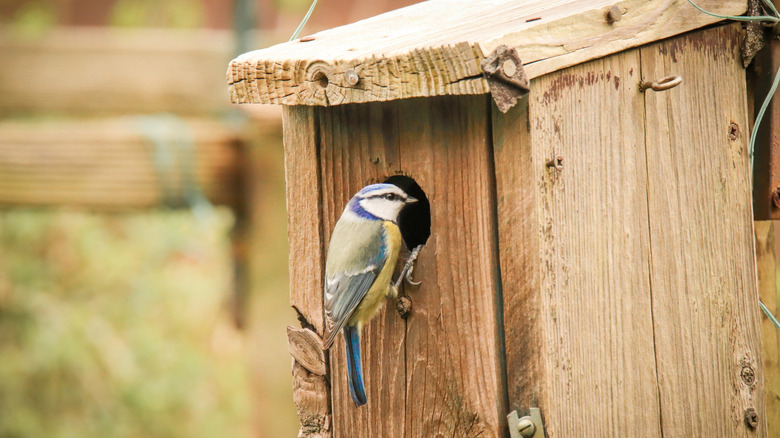The Handy Tool That Keeps Feathered Friends Coming Back To Your Yard
Attracting birds to your garden and yard adds living beauty and wonder to your outdoor space. Pair these woodland creatures with butterflies and bees, and you not only have pollinators that will help your garden, but you're also supporting your local ecosystem. One way to keep birds coming back year after year is to provide these visitors with a place to nest. Several species will utilize nesting boxes if you provide them, including wrens, bluebirds, chickadees, titmice, and tree swallows. While these boxes are designed to keep moisture to a minimum, a windy rainstorm can send water through the bird opening, soaking the nesting material inside. One way to combat this issue is to elevate the interior using a nest lift.
These small metal grates allow your avian friends to build their nests above the base of the nesting box. If moisture enters, it will pool underneath the lift instead of soaking the bird's nest (and possibly the mother bird's eggs). If the nesting material sits in water for too long, this could bring about bacterial and fungal growth or spread illness and disease. Additionally, birds dealing with unfavorable conditions during their nesting time will probably find somewhere else to nest the following season. On the other hand, making that small change to your boxes by adding a nest lift may compel them to return.
Adding a lift to your nesting box
To add a nest lift to a new nesting box, simply open the side or top and pop it in. If you've used the box before, be sure to clean it completely for the season before installing the lift. While wearing gloves and a mask, remove all old nesting material and wipe the inside down with soap and water or a diluted vinegar solution. Rinse completely and let it dry for up to two days before setting it up for the season. Once dry, insert the nest lift and place the nesting box back in its spot. Consider adding a guard on the pole that holds up your nesting box to keep snakes and other predators away from the area so your birds can raise their young in peace.
You can also leave nesting materials out for the birds to encourage them to investigate your boxes and return year after year. Pesticide-free grass clippings, twigs, leaves, straw, and sticks are all good choices that your wildlife friends will use and appreciate. Avoid leaving dryer lint, string, yarn, or human hair in the yard as potential nesting material. While these might seem like good options, each of these choices can spell danger for bird parents and their chicks. String, yarn, and hair pose tangling risks, while dryer lint has little structural integrity.
